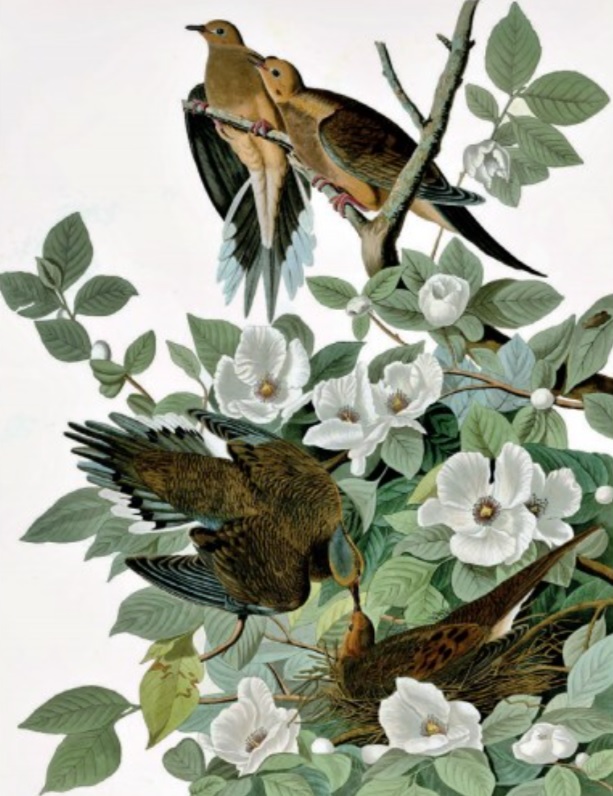Seeing things differently

|
| Mourning doves from The Birds of America. |
JL Carr’s charming novella ‘A Month in the Country’ is set in the Vale of Mowbray in Yorkshire in the summer of 1920. It concerns a rural community in the embers of traditional rural life coming to terms with a rapidly changing world in the aftermath of the first world war. The main narrative thread concerns a month-long contract, funded by a recently deceased benefactress, for the restoration of a Last Judgment in the parish church. As work proceeds, the gradual unfolding of the narrative content leads the restorer into a relationship of understanding and even intimacy with the 14th-century artist.
A Month in the Country was written in Carr’s holiday caravan near Presteigne in 1978. A couple of miles away is The Rodd, a Jacobean manor house which was, from 1983, the last home of the Australian painter Sir Sidney Nolan. The house, which has seen little alteration in 500 years (perhaps because it has always been tenanted), has been nicely restored by the Sidney Nolan Trust, along with the 17th-century barns now converted to a gallery.
This summer’s exhibition was Ngawiya, Ngubadi (To Give With Love). Works by native Australians are popular for their colourful decorative impact but understanding them involves a perspective very different from our western one. Often, like medieval murals, they have a narrative context, but without insight into the artist’s complex oral traditions or the spiritual concept of jukurrpa (dreaming), true understanding is near impossible.
How should we see and understand any work of art? In ‘Modern Painters’, John Ruskin taught us to see things properly, and in ‘Ways of Seeing’, John Berger to see things differently. Both saw the need to question established values.
At the National Museum Cardiff the exhibition ‘The Rules of Art?’ took as a starting point the French Académie Royale’s five-tier ranking, in 1667, of the relative worthiness of artistic subjects. Highest were historical, and religious subjects; next came portraits; then scenes of everyday life; landscape; and, last, still life. This was precisely the rigidity that Ruskin and Berger disdained, and the long succession of subsequent dissident artistic movements that we now regard as mainstream to the history of art provided ample illustration.
An exhibition in Oxford’s Bodleian Library, ‘Sensational Books’, was about books as physical objects, with their production and use viewed in terms of the senses rather than their intellectual content. Pride of place was given to a copy of Audubon’s ‘The Birds of America’, which is simply enormous: when open it measures 1.5m by 1m, and it weighs 23kg. This visual delight can not, alas, be browsed: the pages are too heavy to be turned without risk of tearing. Bodley’s librarians can, it seems, identify books from Duke Humfrey’s library by their smell ‘reminiscent of meadow hay joined with pipe tobacco and cedarwood’. We are all familiar with the expression ‘devouring a book’ and with tooth marks in babies’ literature. In the exhibition one sample board-book had been literally half-devoured by its infant owner.
Such are very limited tastes (sorry) of three fascinating exhibitions seeing things differently.
Back in the Vale of Mowbray, the restoration of the mural was seen by the benefactress as an important contribution to the heritage of the parish, but the vicar saw it as a distraction from the conduct of his mission. Nevertheless, the vicar had to accept it, as the bulk of the legacy coming to the church was conditional on the mural having been completed.
A parallel thread to the restoration is the search for the lost grave of an excommunicated medieval ancestor in the field adjacent to the churchyard, also funded by the deceased benefactress. The archaeologist has spotted the location on day one and spends the rest of his month pursuing his own archaeological interests in another part of the field, triumphantly uncovering the grave on the last day. Nobody bats an eyelid because the only person who was interested in whether he found anything or not was the dear departed.
Ultimately the book and the exhibitions are about contrasting perspectives. As Mark Twain wrote: ‘an open mind leaves a chance for someone to drop a worthwhile thought in it.’
This article originally appeared in the Institute of Historic Building Conservation’s (IHBC’s) Context 175, published in March 2023. It was written by James Caird.
--Institute of Historic Building Conservation
Related articles on Designing Buildings
IHBC NewsBlog
Old Sarum fire in listed (& disputed) WW1 Hangar - Wiltshire Council has sought legal advice after fire engulfed a listed First World War hangar that was embroiled in a lengthy planning dispute.
UK Antarctic Heritage Trust launches ‘Virtual Visit’ website area
The Trust calls on people to 'Immerse yourself in our heritage – Making Antarctica Accessible'
Southend Council pledge to force Kursaal owners to maintain building
The Council has pledged to use ‘every tool in the toolbox’ if urgent repairs are not carried out.
HE’s Research Magazine publishes a major study of the heritage of England’s suburbs
The article traces the long evolution of an internal programme to research 200 years of suburban growth
IHBC Context 183 Wellbeing and Heritage published
The issue explores issues at the intersection of heritage and wellbeing.
SAVE celebrates 50 years of campaigning 1975-2025
SAVE Britain’s Heritage has announced events across the country to celebrate bringing new life to remarkable buildings.
IHBC Annual School 2025 - Shrewsbury 12-14 June
Themed Heritage in Context – Value: Plan: Change, join in-person or online.
200th Anniversary Celebration of the Modern Railway Planned
The Stockton & Darlington Railway opened on September 27, 1825.
Competence Framework Launched for Sustainability in the Built Environment
The Construction Industry Council (CIC) and the Edge have jointly published the framework.
Historic England Launches Wellbeing Strategy for Heritage
Whether through visiting, volunteering, learning or creative practice, engaging with heritage can strengthen confidence, resilience, hope and social connections.














